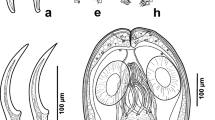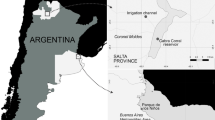Abstract
Brine shrimp, Artemia spp., act as intermediate hosts for a range of cestode species that use waterbirds as their final hosts. These parasites can have marked influences on shrimp behavior and fecundity, generating the potential for cascading effects in hypersaline food webs. We present the first comprehensive study of the temporal dynamics of cestode parasites in natural populations of brine shrimp throughout the annual cycle. Over a 12-month period, clonal Artemia parthenogenetica were sampled in the Odiel marshes in Huelva, and the sexual Artemia salina was sampled in the Salinas de Cerrillos in Almería. Throughout the year, 4–45 % of A. parthenogenetica were infected with cestodes (mean species richness = 0.26), compared to 27–72 % of A. salina (mean species richness = 0.64). Ten cestode species were recorded. Male and female A. salina showed similar levels of parasitism. The most prevalent and abundant cestodes were those infecting the most abundant final hosts, especially the Greater Flamingo Phoenicopterus ruber. In particular, the flamingo parasite Flamingolepis liguloides had a prevalence of up to 43 % in A. parthenogenetica and 63.5 % in A. salina in a given month. Although there was strong seasonal variation in prevalence, abundance, and intensity of cestode infections, seasonal changes in bird counts were weak predictors of the dynamics of cestode infections. However, infection levels of Confluaria podicipina in A. parthenogenetica were positively correlated with the number of their black-necked grebe Podiceps nigricollis hosts. Similarly, infection levels of Anomotaenia tringae and Anomotaenia microphallos in A. salina were correlated with the number of shorebird hosts present the month before. Correlated seasonal transmission structured the cestode community, leading to more multiple infections than expected by chance.


Similar content being viewed by others
References
Abatzopoulos TJ, Beardmore JA, Clegg JS, Sorgeloos P (2002) Artemia: basic and applied biology. Kluwer Academic Publishers, Dordrecht
Amarouayache M, Derbal F, Kara MH (2009) The parasitism of Flamingolepis liguloides (Gervais, 1847) (Cestoda, Hymenolepididae) in Artemia salina (Crustacea, Branchiopoda) in two saline lakes in Algeria. Acta Parasitol 54:330–334
Amat F, Gozalbo A, Navarro JC, Hontoria F, Varó I (1991a) Some aspects of Artemia biology affected by cestode parasitism. Hydrobiol 212:39–44
Amat F, Illescas P, Fernández J (1991b) Brine shrimp Artemia from Spanish Mediterranean salterns parasitized by Flamingolepis liguloides (Cestoda, Hymenolepididae) cysticercoids. Vie et Milieu 41:237–244
Amat JA, Rendon MA, Rendon-Martos M, Garrido A, Ramirez JM (2005a) Ranging behaviour of greater flamingos during the breeding and post-breeding periods: linking connectivity to biological processes. Biol Cons 125:183–192
Amat F, Hontoria F, Ruiz O, Green AJ, Sánchez MI, Figuerola J, Hortas F (2005b) The American brine shrimp Artemia franciscana as an exotic invasive species in the Western Mediterranean. Biol Inv 7:37–47
Brendonck L, De Meester L (2003) Egg banks in freshwater zooplankton: evolutionary and ecological archives in the sediment. Hydrobiol 491:65–84
Bush AO, Lafferty KD, Lotz JM, Shostak AW (1997) Parasitology meets ecology on its own terms: Margolis et al. revisited. J Parasitol 83:575–583
Cézilly F, Thomas F, Médoc V, Perrot-Minnot MJ (2010) Host-manipulation by parasites with complex life cycles: adaptive or not? Trends Parasitol 26:311–317
Chubb JC (1980) Seasonal occurrence of helminths in freshwater fishes. Part III. Larval Cestoda and Nematoda. Adv Parasitol 18:1–120
Gabrion C, MacDonald G, Boy V (1982) Dynamique des populations larvaires du cestode Flamingolepis liguloides dans une population d´Artemia en Camargue. Acta Oecol 3(2):273–293
Georgiev BB, Sánchez MI, Green AJ, Nikolov PN, Vasileva GP, Mavrodieva RS (2005) Cestodes from Artemia parthenogenetica (Crustacea, Branchiopoda) in the Odiel Marshes, Spain: a systematic survey. Acta Parasitol 50:105–117
Georgiev BB, Sánchez MI, Vasileva GP, Nikolov PN, Green AJ (2007) Cestode parasitism in invasive and native brine shrimps (Artemia sp.) as a possible factor promoting the rapid invasion of A. franciscana in the Mediterranean region. Parasitol Res 101:1647–1655
Green AJ, El Hamzaoui M, El Agbani MA, Franchimont J (2002) The conservation status of Moroccan wetlands with particular reference to waterbirds and to changes since 1978. Biol Cons 104:71–82
Hechinger RF, Lafferty KD (2005) Host diversity begets parasite diversity: bird final hosts and trematodes in snail intermediate hosts. Proc R Soc Lond B 272:1059–1066
Hechinger RF, Lafferty KD, Dobson AP, Brown JH, Kuris D (2011) A common scaling rule for abundance, energetics, and production of parasitic and free-living species. Science 333:445–448
Johnson AR (1997) Long-term studies and conservation of Greater Flamingos in the Camargue and Mediterranean. Colon Waterbirds 20:306–315
Johnson AR (2000) An overview of the Greater Flamingo ringing program in the Camargue (southern France) and some aspects of the species' breeding biology studied using marked individuals. Waterbirds 23:2–8
Lafferty KD (1992) Foraging on prey that are modified by parasites. Am Naturalist 140:854–867
Lafferty KD, Sammond DT, Kuris AM (1994) Analysis of larval trematode communities. Ecology 75:2275–2285
Maksimova AP (1988) A new cestode, Wardium gvozdevi sp. n. (Cestoda, Hymenolepididiae), and its biology. Fol Parasitol 35:217–222
Martí R, del Moral JC (eds.) (2002) La invernada de aves acuáticas en España. Dirección General de la Naturaleza SEO/BirdLife, Organismo Autónomo Parques Nacionales, Ministerio de Medio Ambiente, Madrid
McNeil R, Drapeau P, Goss-Custard JD (1992) The occurrence and adaptive significance of nocturnal habits in waterfowl. Biol Rev 67:381–419
Muñoz J, Gómez A, Green AJ, Figuerola J, Amat F, Rico C (2008) Phylogeography and local endemism of the native Mediterranean brine shrimp Artemia salina (Branchiopoda: Anostraca). Mol Ecol 17:3160–3177
Muñoz J, Gómez A, Green AJ, Figuerola J, Amat F, Rico C (2010) Evolutionary origin and phylogeography of the diploid obligate parthenogen Artemia parthenogenetica (Branchiopoda: Anostraca). PLoS One 5(8):e11932
Mura G (1995) Cestode parasitism (Flamingolepis liguloides Gervais, 1847) Spassky & Spasskaja, 1954 in an Artemia population from south-western Sardinia. Int J Salt Lake Res 3:191–200
Pietrock M, Marcogliese DJ (2003) Free-living endohelminth stages: at the mercy of environmental conditions. Trends Parasitol 19(7):293–299
Redón S, Amat F, Hontoria F, Vasileva GP, Nikolov PN, Georgiev BB (2011) Participation of metanauplii and juvenile individuals of Artemia parthenogenetica (Branchiopoda) in the circulation of avian cestodes. Parasitol Res 108:905–912
Rendón MA, Green AJ, Aguilera EY, Almaraz P (2008) Status, distribution and long term changes in the waterbird community wintering in Doñana, south-west Spain. Biol Conserv 141:1371–1388
Rice WR (1989) Analyzing tables of statistical tests. Evol 43:223–225
Robert F, Gabrion C (1991) Cestodoses de l´avifaune camarguaise. Rôle d´Artemia (Crustacea, Anostraca) et stratégies de rencontre hôte-parasite. Ann Parasit Hum Comp 66(5):226–235
Roberts MG, Dobson AP, Arneberg P, de Leo GA, Krecek RC, Manfredi MT, Lanfranchi P, Zaffaroni E (2002) Parasite community ecology and biodiversity. In: Hudson PJ, Rizzoli A, Grenfell BT, Heesterbeek H, Dobson AP (eds) The ecology of wildlife diseases. Oxford University Press, Oxford, pp 63–82
Rodríguez-Pérez H, Green AJ (2006) Waterbird impacts on widgeongrass Ruppia maritima in a Mediterranean wetland: comparing bird groups and seasonal effects. Oikos 112:525–534
Sakanari J, Moser M (1985) Infectivity of, and laboratory infection with, an elasmobranch cestode, Lacistorynchus tenuis (Van Beneden, 1858). J Parasitol 7:788–791
Sánchez MI, Green AJ, Castellanos EM (2005) Seasonal variation in the diet of Redshank Tringa totanus in the Odiel Marshes, southwest Spain: a comparison of faecal and pellet analysis. Bird Study 52:210–216
Sánchez MI, Green AJ, Castellanos EM (2006a) Temporal and spatial variation of an aquatic invertebrate community subjected to avian predation at the Odiel saltpans (SW Spain). Arch Hydrobiol 166:199–223
Sánchez MI, Georgiev BB, Nikolov PN, Vasileva GP, Green AJ (2006b) Red and transparent brine shrimps (Artemia parthenogenetica): a comparative study of their cestode infections. Parasitol Res 100:111–114
Sánchez MI, Green AJ, Castellanos EM (2006c) Spatial and temporal fluctuations in presence and use of chironomid prey by shorebirds in the Odiel saltpans, south-west Spain. Hydrobiol 567:329–340
Sanchez MI, Green AJ, Amat F, Castellanos EM (2007a) Transport of brine shrimps via the digestive system of migratory waders: dispersal probabilities depend on diet and season. Mar Biol 151:1407–1415
Sánchez MI, Georgiev BB, Green AJ (2007b) Avian cestodes affect the behaviour of their intermediate host Artemia parthenogenetica: an experimental study. Behav Process 74:293–299
Sánchez MI, Hortas F, Figuerola J, Green AJ (2009a) Sandpipers select red brine shrimps rich in both carotenoids and parasites. Ethol 115:196
Sánchez MI, Thomas F, Perrot-Minnot MJ, Biron DG, Bertrand-Michel J, Missé D (2009b) Neurological and physiological disorders in Artemia harbouring manipulative cestodes. J Parasitol 95:20–24
Sánchez MI, Varo N, Matesanz C, Ramo C, Amat JA, Green AJ (2013) Cestodes change the isotopic signature of brine shrimp Artemia hosts: implications for aquatic food webs. Int J Parasitol 43:73–80
Scholz T (1993) On the development of Khawia baltica Szidat, 1942 (Cestoda: Lytocestidae) a parasite of tench, Tinca tinca (L.). Fol Parasitol 40:99–103
Snow DW, Perrins CM, Hillcoat B, Gillmor R, Roselaar CS (1997) The birds of the Western Palearctic, concise edition. Oxford University Press, Oxford, New York
Thiéry A, Robert F, Gabrion R (1990) Distribution des populations d´Artemia et de leur parasite Flamingolepis liguloides (Cestoda, Cyclophyllidea) dans les salins du littoral méditerranéen français. Can J Zool 68:2199–2204
Varó I, Taylor AC, Navarro JC, Amat F (2000) Effect of parasitism on the respiration rates of adults of different Artemia strains from Spain. Parasitol Res 86:772–774
Varo N, Green AJ, Sánchez MI, Ramo C, Gómez J, Amat J (2011) Behavioural and population responses to changing availability of Artemia prey by moulting black-necked grebes, Podiceps nigricollis. Hydrobiol 664:163–171
Vasileva GP, Redón S, Amat F, Nikolov PN, Sánchez MI, Lenormand T, Georgiev BB (2009) Records of cysticercoids of Fimbriarioides tadornae Maksimova, 1976 and Branchiopodataenia gvozdevi (Maksimova, 1988) (Cyclophyllidea: Hymenolepididae) from brine shrimps at the Mediterranean coasts of Spain and France, with a key to cestodes from Artemia spp. from the Western Mediterranean. Acta Parasitol 54:143–150
Viada C (ed) (1998) Areas Importantes para las Aves en España. Monografía, 5. SEO/BirdLife. Madrid
Wetlands International (2006) Waterbird population estimates, fourth edition. Wetlands International, Wageningen, the Netherlands
Acknowledgments
The Consejería de Medio Ambiente, Junta de Andalucía and Aragonesas Industrias y Energía S. A. provided permission for fieldwork. Waterbird census data were provided by the Consejería de Medio Ambiente. MIS was supported by a Juan de la Cierva postdoctoral contract. T. Stewart and anonymous referees provided comments on drafts. This work was also supported by joint research projects between CSIC and the Bulgarian Academy of Sciences (2004BG0013 and 2005BG0015), by the EC-funded project WETLANET (FP7, Programme CAPACITIES, Grant 229802), by the Consejería de Innovación, Ciencia y Empresa, Junta de Andalucía (P07-CVI-02700) and by the Ministerio de Ciencia e Innovación (Proyecto CGL2010-16028). Any use of trade, product, website, or firm names in this publication is for descriptive purposes only and does not imply endorsement by the U.S. Government.
Author information
Authors and Affiliations
Corresponding author
Additional information
Authors Marta I. Sánchez and Pavel N. Nikolov contributed equally to this work.
Electronic supplementary material
Below is the link to the electronic supplementary material.
ESM 1
(PDF 42 kb)
Rights and permissions
About this article
Cite this article
Sánchez, M.I., Nikolov, P.N., Georgieva, D.D. et al. High prevalence of cestodes in Artemia spp. throughout the annual cycle: relationship with abundance of avian final hosts. Parasitol Res 112, 1913–1923 (2013). https://doi.org/10.1007/s00436-013-3347-x
Received:
Accepted:
Published:
Issue Date:
DOI: https://doi.org/10.1007/s00436-013-3347-x




